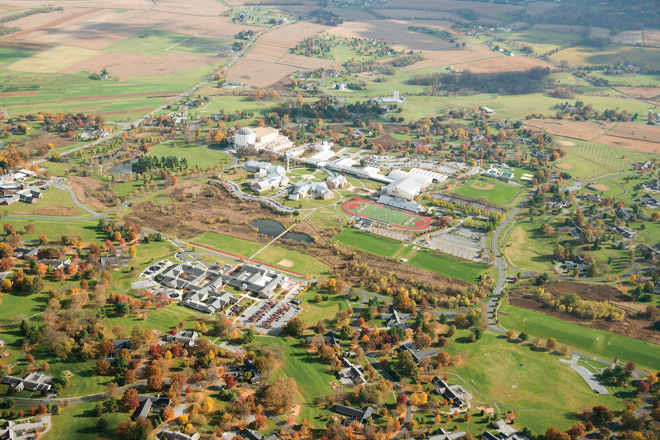Article by Elliott Robinson, Milton Hershey School
Feature image: The expansive campus of Milton Hershey School. Photo courtesy of the school.

Milton Hershey School
Milton Hershey School’s approach to campus safety has changed significantly since the 2012 Sandy Hook tragedy. That incident heightened our resolve to address the evolution of school security, and we embarked on a strategic planning process to enhance our efforts and demonstrate our commitment to school safety. Over the past six years, we have tailored our plan to our school’s characteristics, our families’ expectations and emerging best practices — and we continue to refine it as necessary.
Milton Hershey School (MHS) has the unique opportunity to provide cost-free preschool-grade 12 education and housing to 2,100 students. All expenses are funded by a trust established by the school’s founders, and admission is limited to U.S. families who earn no more than two times a poverty level income. Our 7,200-acre physical plant plays a key role in providing students a safe and family-like environment and supports more than 180 student homes, each supervised by a houseparent with childcare experience. With so many students, faculty and staff members, and guests on campus, developing and maintaining safety programs to secure campus are critical.
Our school safety program is shaped by the following expectations:
- The school has the ability to serve as a first responder and manage all hazards.
- The school employs an appropriate number of trained staff who receive appropriate professional safety training.
- The school integrates technology as appropriate across its safety programs.
- The school engages the school community (students, staff and guests) in safety training programs.
- The school works with local law enforcement to provide effective mutual aid.
The non-sworn status of our campus safety department supports our values-based approach to student behavior rather than a law enforcement approach.
In 2014, MHS worked with a nationally recognized school safety consultant to perform a threat and vulnerability assessment. This report discretely identified gaps in existing school safety programs, procedures, training, supervision and policies. Drawing on these recommendations, school leaders systematically prioritized and allocated resources over five years to redesign our safety efforts and approach. MHS estimated costs for each recommendation and prioritized them in the annual budget planning process over the five-year period. The following advancements were achieved.
Enhanced Security Officer Training
MHS is the only K-12 school in the country with an accreditation from the Commission on Accreditation for Law Enforcement Agencies (CALEA), the “gold standard” in public safety. We are a non-sworn agency, which means our patrol officers do not have law enforcement authority. With this accreditation, we follow a comprehensive set of standards and codified best practices for health and safety procedures and processes. The non-sworn status of our campus safety department supports our values-based approach to student behavior rather than a law enforcement approach.

The accreditation process took two and a half years and requires that the school demonstrate its ability to comply with 207 standards, ranging from organizational structure, direction and supervision, human resources, recruitment, training, operations and critical incidents. This was an important step for the school to take because it helped us address historical challenges, including an overall lack of vision for the role of campus security and unclear expectations of campus safety service levels. Having an accredited agency also helps MHS fortify its relationship as an inter-entity with the Hershey Company, Hershey Entertainment and Resorts, Hershey Medical Center and the local township, and improve inter-organizational safety planning and collaboration.
Law Enforcement Support
It was important to build strong working relationships with our first responders, as response time is particularly critical for MHS. Our campus is one of the largest in the country, and the adjacent theme park, and other tourist attractions bring increased activity during the summer tourist season. As part of our ongoing relationship with local law enforcement, we are able to cross-train and exchange resources to help each other meet community safety expectations. Recent trainings cover a range of topics, including tactical measures with less lethal options, de-escalation techniques, tactical medicine and bleeding control, implicit-bias-awareness training and mental health first aid.
Call Center Accreditation
By diverting non-safety related calls, such as requests for emergency maintenance, to the appropriate channel, we can focus on true safety emergencies and professionalize our response.
MHS has always had a central monitoring department to identify and respond to emergency incidents on campus. The MHS call center accreditation process, which will be complete in fall 2020, will help the existing call center function similarly to a 911 call center. It will actively monitor all surveillance systems and alarms, respond to telephone calls for assistance and deploy campus safety officers along with outside resources when needed. Our accredited monitoring team will have undergone training to demonstrate compliance with CALEA Call Center Standards. These address a range of issues, including emergency dispatch procedures for medical, active shooter or weather emergencies.
Having an accredited call center on campus not only helps us improve emergency response times but also increase the effectiveness of communication channels. By diverting non-safety related calls, such as requests for emergency maintenance, to the appropriate channel, we can focus on true safety emergencies and professionalize our response. Our dispatching technology is integrated with the campus safety officers’ mobile computers, allowing them to exchange and populate information while responding and following up on calls for service.
Integrated Electronic Surveillance and Access Control Systems
The vulnerability assessment reviewed the 600 existing cameras we had at the time and provided recommendations on configuration for a more effective monitoring and response. As a result, the school allocated funding to replace cameras with newer technology and increase total cameras to 600. These are now strategically located and include motion sensor, pan-tilt-zoom and 360-degree capabilities. Call center employees can now view all alarms in the central monitoring screen, a master display for multiple alarm systems located in the call center.
We also ensured that the central monitoring systems were fully integrated to include the following systems:
- Burglar alarms
- CO2 and fire sprinkler alarms
- Mechanical system alarms
- Smart keys (for the more than 1,500 employees on campus)
- Security window screen alarms
- Door access control
- Camera surveillance
With an integrated electronic surveillance and access control system, the school is now better able to identify and respond to a range of risks on campus. In fact, prior to this integration, it would require numerous steps to identify locations and types of alarms, where now it only takes seconds.
Cultural Considerations

In addition to improving safety and security procedures, we have built an inclusive, comprehensive program that can address historical challenges and create synergies. For example, as part of the CALEA accreditation process, the school developed a campus safety vision and mission statement to facilitate a vision of the safe, secure residential learning environment. The development process for the vision and mission statement involved a collaboration among multiple departments, resulting in buy-in from the school community and clearly defined expectations. A survey conducted in fall 2019 revealed that 97% of the school community feel very confident that the campus safety department is capable of providing a safe, secure campus environment.
These advances in school safety cannot guarantee that no unfortunate event will take place on our campus. However, we can provide assurance to our students, families, staff and guests that adequate resources are available and well used to cope with safety challenges.





